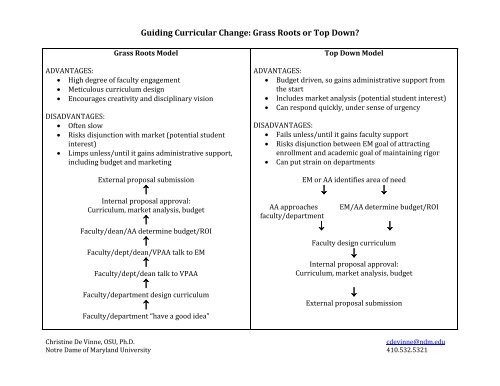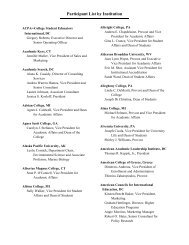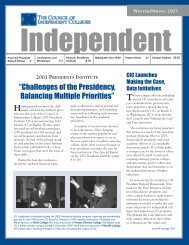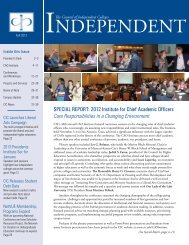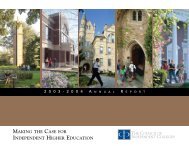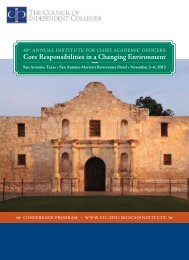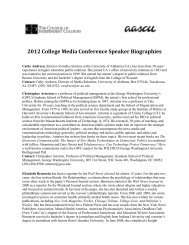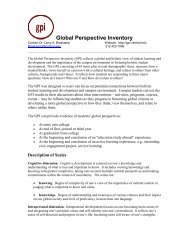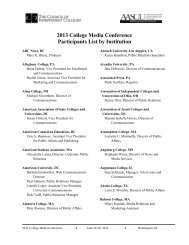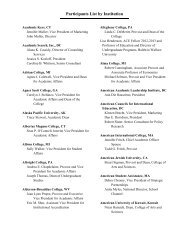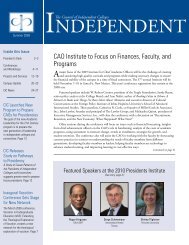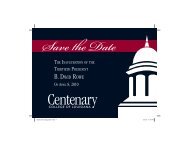Industrial-Organizational Psychology
Industrial-Organizational Psychology
Industrial-Organizational Psychology
You also want an ePaper? Increase the reach of your titles
YUMPU automatically turns print PDFs into web optimized ePapers that Google loves.
Guiding Curricular Change: Grass Roots or Top Down<br />
Grass Roots Model<br />
ADVANTAGES:<br />
• High degree of faculty engagement<br />
• Meticulous curriculum design<br />
• Encourages creativity and disciplinary vision<br />
DISADVANTAGES:<br />
• Often slow<br />
• Risks disjunction with market (potential student<br />
interest)<br />
• Limps unless/until it gains administrative support,<br />
including budget and marketing<br />
External proposal submission<br />
↑<br />
Internal proposal approval:<br />
Curriculum, market analysis, budget<br />
↑<br />
Faculty/dean/AA determine budget/ROI<br />
↑<br />
Faculty/dept/dean/VPAA talk to EM<br />
↑<br />
Faculty/dept/dean talk to VPAA<br />
↑<br />
Faculty/department design curriculum<br />
↑<br />
Faculty/department “have a good idea”<br />
Top Down Model<br />
ADVANTAGES:<br />
• Budget driven, so gains administrative support from<br />
the start<br />
• Includes market analysis (potential student interest)<br />
• Can respond quickly, under sense of urgency<br />
DISADVANTAGES:<br />
• Fails unless/until it gains faculty support<br />
• Risks disjunction between EM goal of attracting<br />
enrollment and academic goal of maintaining rigor<br />
• Can put strain on departments<br />
EM or AA identifies area of need<br />
↓ ↓<br />
AA approaches EM/AA determine budget/ROI<br />
faculty/department<br />
↓ ↓<br />
Faculty design curriculum<br />
↓<br />
Internal proposal approval:<br />
Curriculum, market analysis, budget<br />
↓<br />
External proposal submission<br />
Christine De Vinne, OSU, Ph.D. cdevinne@ndm.edu<br />
Notre Dame of Maryland University 410.532.5321
Guiding Curricular Change: Grass Roots or Top Down<br />
Strong colleges and universities thrive on strong curricula. What planning strategies build the<br />
most robust programs On what common ground do creative ideas from faculty meet<br />
institutional growth needs relayed by administrators<br />
Mini Case Study: Filling a Gap for Non-Traditional Students<br />
The College of Adult Undergraduate Studies (CAUS) at Notre Dame of Maryland University<br />
enrolls a thousand non-traditional aged part-time students in evening and weekend classes.<br />
Most students work full-time; some begin their college experience in CAUS, while others bring<br />
transcripted credits. In addition to three professional programs (education, nursing, and<br />
business), CAUS offers six liberal arts majors. However, the 2010 discontinuation of the Human<br />
Services major left a gap: other than a specialized, low-enrollment criminology major, now there<br />
was no major in the social sciences.<br />
With a goal of increasing enrollment, a consultant was asked to determine interest areas of<br />
potential CAUS students and identified the social sciences. The VPEM then approached the VPAA<br />
with a request for a program in the social sciences, potentially something in psychology, which<br />
generated a high number of inquiries annually, but not the existing research-based psychology<br />
major, since CAUS students typically avoid programs that require statistics and methods courses.<br />
The psychology department recognized a number of difficulties.<br />
1. The department oversaw a collection of majors: psychology, behavioral neuroscience,<br />
criminology and social deviance, as well as human services, still being completed by<br />
remaining enrollees; physical education was also housed there. Taking on a new major in<br />
CAUS would stretch an already extended department.<br />
2. Departmental commitment to rigor and research had contributed to the decision to<br />
sunset human services. The department expressed concern about any new major,<br />
especially in an applied field, that might appear to be “psychology lite.”<br />
3. The department already offered criminology in CAUS. By adding a new major, they risked<br />
competing against themselves for enrollment.<br />
A (protracted! but amazingly productive) series of emails generated strong positive response<br />
from both EM and the department around:<br />
<strong>Industrial</strong>-<strong>Organizational</strong> <strong>Psychology</strong><br />
A. It is a recognized division of APA, so it passes the legitimacy litmus test.<br />
B. It has an interdisciplinary foundation, with a foot in psychology and one in business.<br />
C. That interdisciplinarity allows the department to draw on its own resources and those of<br />
other departments. Curriculum includes a P.E. course in coaching and a course in the<br />
sociology of work, as well as eight psychology courses, plus six business courses.<br />
D. If enrollment hits projected targets, the psychology department will hire a new HT faculty<br />
member in Y2, to be converted to a FT opening in Y3.<br />
From concept to curriculum design, internal approval and external proposal:<br />
6 weeks<br />
Christine De Vinne, OSU, Ph.D.<br />
cdevinne@ndm.edu<br />
Notre Dame of Maryland University 410.532.5321


